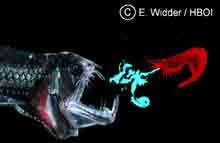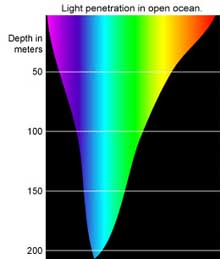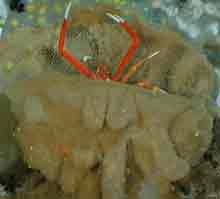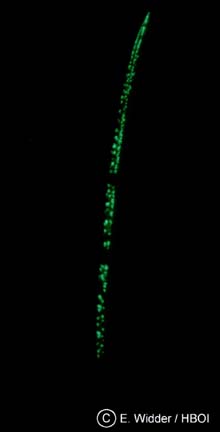
Examples of how animals use bioluminescence to survive in the ocean's dark depths. Click image for more pictures and larger view.
Deep Light
Edith Widder
Senior Scientist
Harbor Branch Oceanographic Institution
Look beneath the ocean’s surface, and you are immediately aware of how water transforms light. Colors appear differently here, because water absorbs warm colors like reds and oranges (known as long wavelength light) and scatters the cooler colors (known as short wavelength light).
If you take a red object under water with you, the deeper you go the less red it will appear. This happens because there is a decreasing amount of red light available to reflect back to your eye. Remember that a red apple appears red because it absorbs all other colors and reflects red light. If there is no red light available, the apple will look gray or black.
You can demonstrate this for yourself. Cover a flashlight with a blue filter and use it to look at a red object in a dark room. Against a black background the red object will seem to disappear. It is important to remember this fact when you see pictures of bright red animals in the deep ocean. We can see they are red, because we use bright white lights on the submersible to illuminate them. But in the dim blue light, which is their natural environment, they will appear gray or black.
Water not only changes the color of sunlight, it dramatically changes its intensity. In clear ocean water, visible light decreases approximately 10-fold for every 75 m that you descend. This means that at 75 m the light is 10% as bright as it was at the surface; and at just twice that depth, 150 m, it is another 10-fold dimmer, or 1% of surface light. Below this depth there is insufficient light for photosynthesis, but there is still plenty of light for seeing. This is because eyes are useful over an astonishing range of intensities.
Light conditions affect the functionality of both human eyes and fish eyes. Human eyes, for example, are functional in bright sunlight at high noon and under dim starlight on a moonless night. This is a range of about 12 "orders of magnitude," with each order of magnitude representing a 10-fold difference. Under water (where light decreases 10 fold with every 75 m of descent), the human eye theoretically can detect light down to almost 900 m. The eyes of deep-sea fish, however, may be functional down to 1000 m. Their eyes show remarkable adaptations and may be 10 to 100 times more sensitive than ours. Even below 1000 m there are many animals with functional eyes. These eyes that have evolved to detect bioluminescence (the emission of light by a living organism).

This diagram offers a basic illustration of the depth at which different colors of light penetrate ocean waters. Water absorbs warm colors like reds and oranges (known as long wavelength light) and scatters the cooler colors (known as short wavelength light). Click image for larger view and image credit.
Ocean animals that can make light are everywhere, often in very high abundance. Bioluminescence is common because it provides a significant survival advantage in the dim dark depths.(On land, bioluminescence is a relatively rare phenomenon, with fireflies being the best-known light-producers.) It helps animals find food, either with the aid of a built-in "flashlight"or by means of a "lure," and it is used to attract mates and to defend against predators.
The light is the product of a very efficient chemical reaction. Light produced in this way is called chemiluminescence. Light sticks are a well-known example of chemiluminescence. Bioluminescence is just one form of chemiluminescence -- one where the chemicals are synthesized by living organisms. These chemicals are referred to as luciferin and luciferase, which often leads people to assume that all animals produce the same light-producing chemicals. However, there are number of different luciferins and luciferases, which indicates that bioluminescence evolved multiple times during evolutionary history -- a clear indication of what an important survival advantage it provides.
The survival advantage of luminescence in many mid-water animals seems apparent, but the same cannot be said of the bioluminescence of the animals that live on or near the bottom of the ocean. There is much we still have to learn about how animals have adapted to survive in these dim depths.


























